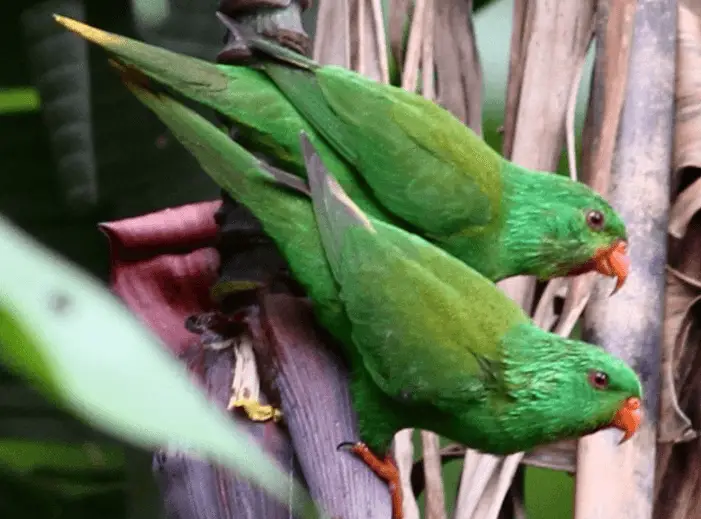
Palm Lorikeet 15–17 cm. Green, with rather small red patch around bill from lores to chin; mantle washed pale brown; underwing-coverts greyish green; tail tipped yellow; bill and legs orange. Palm Lorikeet Female has red reduced or lacking, no brown. Immature like a female.
Forms a species group with C. rubrigularis, C. meeki and C. toxopei. Monotypic.
Subspecies
Monotypic.
Distribution
Extreme E Solomon Is (Santa Cruz Is, Duff Is, Reef Is), Banks Is and Vanuatu; the range seems to be somewhat irregular and fluctuates with cycles of extinctions and recolonizations over decades.
Habitat
Montane and lowland forest, but seemingly intolerant of disturbed areas at lower levels.
Movement
Apparently nomadic, traveling widely between feeding areas and appearing unpredictably in coastal areas, sometimes in large numbers.
Diet and Foraging
Palm Lorikeet eat Nectar and pollen of various trees, palms, lianas, and shrubs, notably from flowers of sago palms (Metroxylon rumphii) and Erythrina; also take the fruit of figs (Ficus) and berries
Palm lorikeet (Vini palmarum) Tabwemasana bird survey 2021
SOURCE: Dominik Maximilián Ramík
Sounds and Vocal Behavior
The commonest vocalization of Palm Lorikeet is a high-pitched short “tseet”. When perched, also utters a high-pitched twittering and short chirruping notes.
Breeding
One nest on Vanuatu in Dec, was in a hollow limb of a tree c. 6 m up, in the cloud forest (at 1600 m), with two half-grown young.
Conservation Status
VULNERABLE. CITES II. Previously considered Near Threatened. A BirdLife “restricted-range” species. Commoner in hills above 1000 m than in lowlands.




















